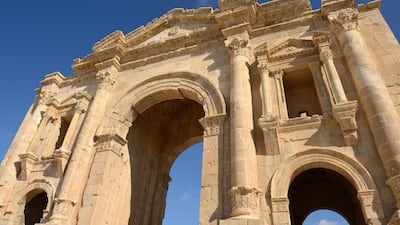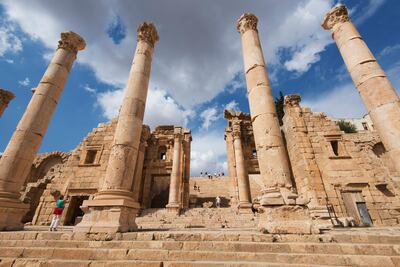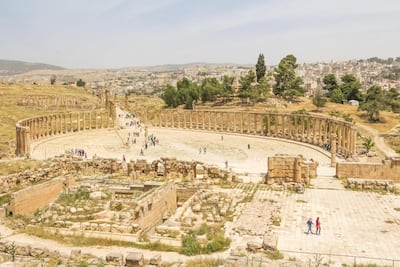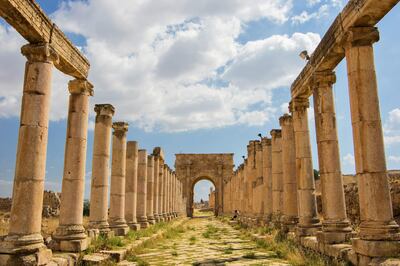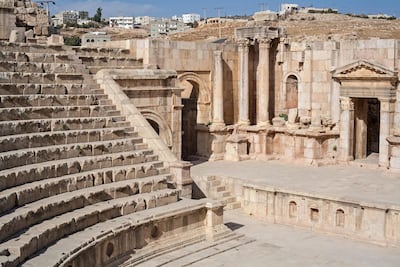There's no escaping the hawkers in Jordan. Bottles of cold water, hats, umbrellas, shawls, toy camels, carpets and random assortments of nik-naks that may or may not have anything to do with the location you're visiting – everything is for sale, all of the time. And while it might be relatively simple to dismiss the men attempting to foist upon you an "I Love Petra" mug or fridge magnet when you're visiting an entirely different location, you'd be advised to accept some of that water or one of those hats, especially if you're stepping into the ruined city of Jerash in the heights of summer.
It’s perhaps tempting to think of Jerash as Petra’s poor relation, but that’s to do it a great disservice. This is, after all, the kingdom’s largest and most archaeologically important Roman site – which is quite the statement when Jordan isn’t exactly short of them. The capital, Amman, was known as Philadelphia when it was a settlement for the Greeks before the Romans descended, and the evidence of those occupations is inescapable throughout the city – so much so that the ruins and artefacts stop turning your head after a very short while. But Jerash is something else entirely.
If it’s on your to-do list, Amman will be your first port of call, not least because it’s Jordan’s aviation hub. This city of approximately four million inhabitants, which has evolved over millennia and covers the surrounding hillsides as far as the eye can see, is a fascinating amalgam of old and new. And about an hour’s drive north from its maddening, Kamikaze traffic, there is Jerash in all its broken, magisterial splendour.
Naturally, before you can explore the place, your route takes you through the Jerash Museum, where traders ply their wares and offer “best price” for whatever it is they’re trying to unload. The temperature outside is scalding and I’ve forgotten to bring a hat to protect my thinning pate, so to the delight of the first man I see selling them, I choose a cap with, yes, “Petra” stitched into its fabric. Water. Must buy water and sunscreen, too, for the tour of the ruins is a lengthy one – this was once a major city in the Roman Empire, after all, and the (fortunately) dry, relentless heat will soon have anyone dehydrated and burnt to a crisp.
Modern Jerash has grown around and over the Greco-Roman original, with the walled ruins directly adjacent to rows of cafes and shops selling car tyres – a weird yet somehow expected juxtaposition. Scrambling up the dusty hill to the entrance, the Arch of Hadrian, you’re under no misapprehension. This 21-metre high structure was built to honour the visit of Emperor Hadrian (he of the United Kingdom wall fame) in the winter of 129AD to 130AD and it’s a remarkable structure, surrounded by sections of stone pillars and inscribed portions yet to be restored to their original positions. This is, it’s obvious from the outset, a work in progress.
All around the arch are more hawkers offering even more bottled water and various tour guide services. Once you’re through, however, you get your first sense of how big this place really is, with countless columns and walls disappearing towards the distant hillsides. One can only begin to imagine how imposing this must have been to visitors when ancient Jerash was occupied.
To the left, the partly restored hippodrome, where chariots once raced and slaves were no doubt lanced. Rows of stone seating line one side, the site once able to accommodate 15,000 spectators. There’s room for 500 at the moment, the restoration process frozen while tourist numbers are low, but it’s easy to form a mental impression of what it was like here many centuries ago, before the devastating earthquakes that reduced the entire place to rubble.
There’s precious little in the way of signage anywhere, so either do some extensive homework before you visit or arrange for a knowledgeable guide to take you round. Ours has been arranged by our hotel, the new Fairmont Amman, and he explains how every stone façade was once covered in marble – the place must have positively shimmered. At every turn there’s something to take in but there are undoubted highlights. The forum, for instance, remains enclosed by 56 original Ionic columns out of a former tally of 160, wrapping around the oval plaza paved with limestone in a crazily intricate and visually clever vortex pattern that radiates outwards.
Looking over it, high up on a hillside, the ruins of the Temple of Zeus, excavated during the 1930s, are worth clambering to, not least because the high walls of what's left of the main structure afford some shade. The remaining 15-metre high Corinthian columns are enormous and beautifully preserved, and the commanding views over the rest of the city justify spending a few minutes gazing while perched on a random piece of ancient architectural masonry.
Back down and wander up the colonnaded main street, the Cardo Maximus, with its original stones making for uneasy progress even when wearing sensible shoes. Ruts worn by the wheels of chariots are still visible and stretch for nearly a kilometre, ending after passing through the Gate to Damascus, and the North Gate that marks the boundary of this fascinating antiquity.
Turn around and begin your return, but make sure to take in the beautifully restored North Theatre, the central Nymphaeum where fountains once supplied the city’s drinking water, and the incredibly imposing (and never completed) Temple of Artemis with its stunning staircase. And don’t miss the South Theatre, which would be easy to do, its nondescript entrance leading to a covered passage way that opens to an incredible, 5,000-seat venue that is today used for the annual Jerash Festival of Culture and Arts.
The acoustics are genius – from a specific point on the floor, a speaker is able to address the entire assembly without raising his or her voice.
It takes three, maybe four hours to get the full experience and even those with only a passing interest in how life used to be will find Jerash a moving and memorable experience. But there’s more to be explored in this part of Jordan, with the small city of Madaba just 32km southwest of Amman. It’s Jordan’s fifth-most populous city and is renowned for its Byzantine mosaics, the most famous of which is housed within the Basilica of Saint George. A figurative crossroads for Islam, Judaism and Christianity, Madaba is proud of its social and religious inclusion and it remains a vitally important part of this country’s history.
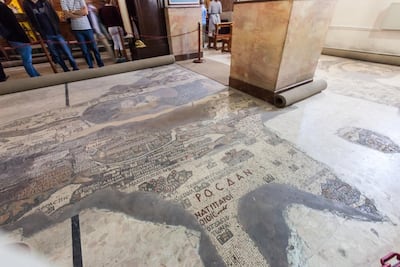
A short drive northwest of Madaba is Mount Nebo. Here, the recently reconstructed Memorial Church of Moses, run by a group of Franciscan monks as a functioning monastery, houses some of Jordan’s finest ancient mosaics and outside, in its colourful garden grounds, there are stunning vistas to be taken in and enjoyed from one of the kingdom’s best vantage points. The Dead Sea, the Jordan River, the West Bank and Bethlehem are all visible from here.
Jordan drips with ancient history but too many visitors land and head straight to the Dead Sea, Petra and Wadi Rum. Each is entirely remarkable in its own right, of course, but ignore Amman’s surrounding attractions and you’ll miss out on some of the most significant historical sites anywhere in the world. Just remember to take your hat.
_______________
Read more:
Archaeologists take flight over Jordan’s ancient wonders
How street artists have made Amman their canvas - with dramatic effect
The 'love pirates' of Petra: female tourists fall victim to romance scam in Jordan
On a trip to Jordan, is a stay in Amman worthwhile?
_______________
